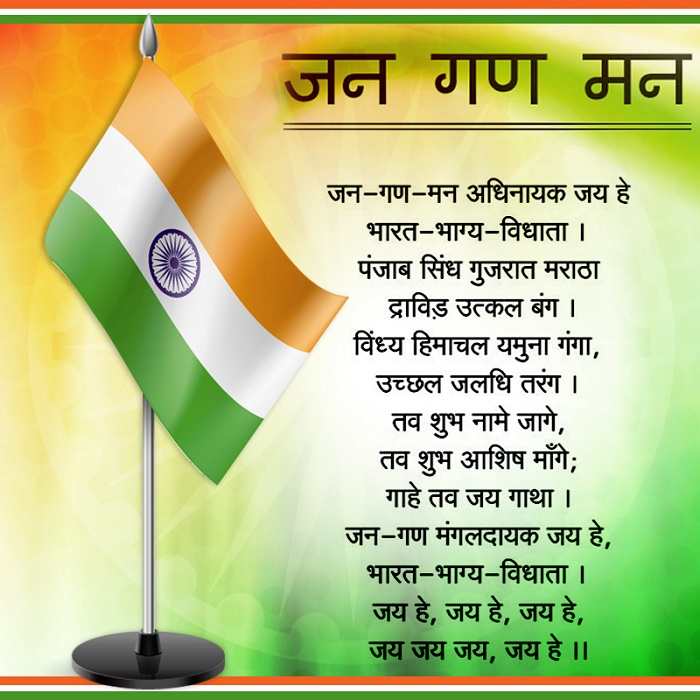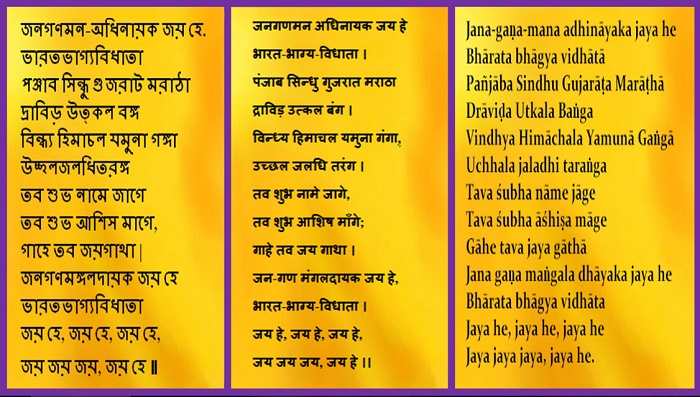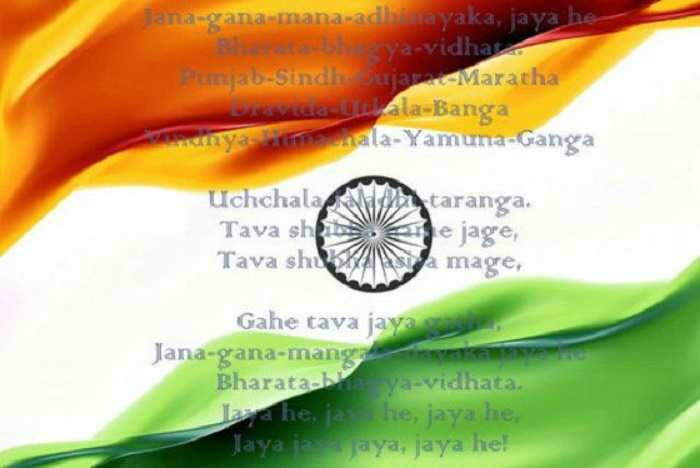Title: Jana Gana Mana
Music by: Rabindranath Tagore
Lyrics by: Rabindranath Tagore
Raga: Alhiya Bilawal
Written on: December 11, 1911
First sung on: December 27, 1911
Declared as National Anthem on: January 24, 1950
Time to play: 52 seconds
Underlying message: Pluralism/Unity in Diversity

National Anthem refers to a musical composition that has been selected by an authorized government bodyand is meant to represent a country’s patriotic ethos. It generally helps citizens relate to the country’s spiritual and philosophical sentiments, its rich culture and colorful history. The national anthem presents a country’s identity to the world and it acts as an instrument of unity among its citizens.
The National Anthem of India is entitled ‘Jana Gana Mana’. The song was originally composed in Bengali by India’s first Nobel laureate Rabindranath Tagore on December 11, 1911. The parent song, ‘Bharoto Bhagyo Bidhata’ is a Brahmo hymn which has five verses and only the first verse has been adopted as National Anthem. If put forwards succinctly, the National Anthem conveys the spirit of pluralism or in more popular term the concept of ‘Unity in Diversity’, which lies at the core of India’s cultural heritage.

Image Credit: www.prayer-international.org/india/images/indian_anthem.jpg
Lyrics and Translation
The original song ‘Jana Gana Mana’ is written in Bengali, but in a Sanskritized dialect known as Sadhu Bhasha. The words are primarily noun but can be used as verbs alternatively. The words again are common in most of the Indian languages and are accepted as such. They remain unchanged in most of them but the pronunciation varies according to the predominant accent of the region. The lyrics of the song are as follows:
Jana-gana-mana-adhinayaka, jaya he
Bharata-bhagya-vidhata.
Punjab-Sindh-Gujarat-Maratha
Dravida-Utkala-Banga
Vindhya-Himachala-Yamuna-Ganga
Uchchala-Jaladhi-taranga.
Tava shubha name jage,
Tava shubha asisa mage,
Gahe tava jaya gatha,
Jana-gana-mangala-dayaka jaya he
Bharata-bhagya-vidhata.
Jaya he, jaya he, jaya he, Jaya jaya jaya, jaya he!
The idea of translating the song from Bengali to English came to Tagore while he was visiting the Besant Theosophical College on the invitation of Irish poet James H. Cousins. He penned down the English translation during his stay at Madanapalle, a small town in the Chittoor district of Andhra Pradesh. The musical notations for the English version were set down by Margaret Cousin, James Cousin’s wife. The English translation goes as follows:
Thou art the ruler of the minds of all people,
Dispenser of India's destiny.
The name rouses the hearts of Punjab, Sind, Gujarat and Maratha,
Of the Dravid and Orissa and Bengal;
It echoes in the hills of the Vindhyas and Himalayas,
Mingles in the music of the Yamuna and Ganga
And is chanted by the waves of the Indian Sea.
They pray for thy blessings and sing thy praise.
The salvation of all people is in thy hand,
Thou dispenser of India's destiny.
Victory, victory, victory to thee.
A shorter version of the National Anthem is also sung on occasions and it consists of the first and last lines of the verse, like
Jana-gana-mana-adhinayaka jaya he
Bharata-bhagya-vidhata.
Jaya he, Jaya he, Jaya he, Jaya Jaya, Jaya, Jaya he.

Image Credit: http://image.indiaopines.com/wp-content/uploads/2015/07/national-anthem.jpg
History of Indian National Anthem
The song ‘Bharat Bhagya Bidhata’ was first sung on the Day 2 of the annual session of the Indian National Congress in Calcutta on December 27, 1911. Song was performed by Sarala Devi Chowdhurani, Tagore’s niece, along with a group of school students, in front of prominent Congress Members like Bishan Narayan Dhar, Indian National Congress President and Ambika Charan Majumdar.
In 1912, the song was published under the title Bharat Bidhata in the Tatwabodhini Patrika, which was the official publication of the Brahmo Samaj and of which Tagore was the Editor.
Outside of Calcutta, the song was first sung by the bard himself at a session in Besant Theosophical College in Madanapalle, Andhra Pradesh on February 28, 1919. The song enthralled the college authorities and they adopted the English version of the song as their prayer song which is sung till today.
On the occasion of India attaining freedom, the Indian Constituent Assembly assembled for the first time as a sovereign body on August 14, 1947, midnight and the session closed with a unanimous performance of Jana Gana Mana.
The members of the Indian Delegation to the General Assembly of the United Nations held at New York in 1947 gave a recording of Jana Gana Mana as the country’s national anthem. The song was played by the house orchestra in front of a gathering consisting of representatives from all over the world.
Jana Gana Mana was officially proclaimed as India’s National Anthem by the Constituent Assembly of India on January 24, 1950.
Occasions for playing the Anthem
The full version of the national anthem requires duration of approximately 52 seconds to be played while the shorter version takes about 20 seconds. The national anthem is a symbol of pride for the citizens of the country and is required to be played on specifically designated occasions which are listed below.
1. The full version of the National Anthem is played on the following occasions:
a. Accompanying the performance of National Salute on ceremonial occasions to the President of India or Governors of States/Union Territories.
b. During parade demonstrations in front of the dignitaries referred in the preceding point
c. before and after the President’s address of the nation
d. Before arrival and departure of the President or Governor from a formal ceremony
e. When the national Flag is hoisted during cultural occasions
f. When the Regimental Colors are presented
2. The National Anthem is not to be played for the Prime Minister generally, except under special circumstances.
3. On the occasion where the National Anthem is performed by a Band, a roll of drums is to precede the actual performance, in order to let the audience know and prepare for paying respect. The roll will be 7 paces of slow march, will start slowly, ascend to a loud volume and should remain audible till the last beat.
National Anthem of India - Code of Conduct
A specific set of rules and regulations have been set by the Government of India to oversee the proper and correct rendition of the National Anthem. The Prevention of Insults to National Honour Act, 1971, was penned down by the Government of India to prevent any intentional disrespect or insult towards the National Anthem of the country. Offenders are punishable with up to three years of imprisonment as well as monetary fine.
The following codes of conduct are to be observed by Indian citizens whenever the National Anthem is played:
1. Should stand up to attention.
2. Individual’s head should be held high
3. One should be looking forward.
4. Mass singing of the National Anthem is to accompany the unfurling of the National Flag.
5. No parody/distortion of words or music of the National Anthem is allowed.
Significance
The National Anthem is perhaps one of the most potent declarations of a country’s independent status. India is a nation of multiple languages and dialects therein. Jana Gana Mana is understood unequivocally throughout India and thus brings forth the spirit of unity among these diverse languages. Our National Anthem conveys very aptly the traditions and values that still hold strong as the backbone of the country. It helps reinforce the accepting and assimilating nature of Indian culture along with its tolerance to pluralism. Jana Gana Mana appeals to the country’s patriotic emotions and helps unifying the different races, castes and creeds by solemn singing of the hymn-like verses.
Controversies
A controversy surrounds the song Jana Gana Mana from its inception. A section of congress leaders alleged that Tagore wrote this song in praise of King George V as indicated by the use of the words like “Adhinayaka” and “Bharat Bhagya Bidhata”. The creation of the song coincided with the England Monarch’s first visit to India and his Coronation at Delhi Durbar in 1911. But in a letter to Mr. Pulin Bihari Sen in December 1939, Tagore dismissed the idea. He wrote “A certain high official in His Majesty's service, who was also my friend, had requested that I write a song of felicitation towards the Emperor. The request simply amazed me. It caused a great stir in my heart. In response to that great mental turmoil, I pronounced the victory in Jana Gana Mana of that Bhagya Vidhata [ed. God of Destiny] of India who has from age after age held steadfast the reins of India's chariot through rise and fall, through the straight path and the curved. That Lord of Destiny, that Reader of the Collective Mind of India, that Perennial Guide, could never be George V, George VI, or any other George. Even my official friend understood this about the song. After all, even if his admiration for the crown was excessive, he was not lacking in simple common sense.”



